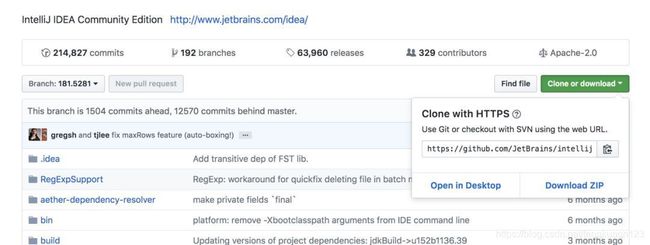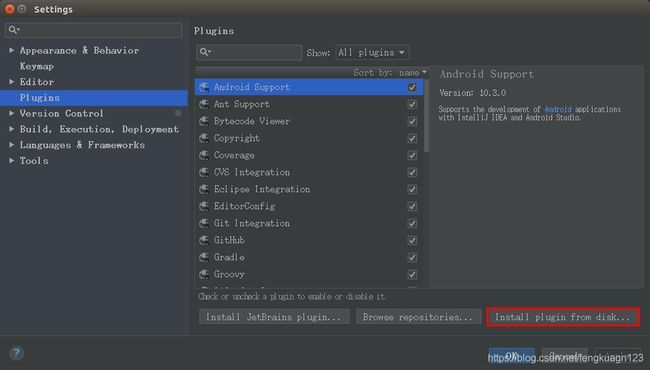IDEA插件开发入门
转自:https://cloud.tencent.com/developer/article/1348741
官方文档:https : //www.jetbrains.org/intellij/sdk/docs/basics/getting_started.html
官网样例:https://github.com/JetBrains/intellij-sdk-code-samples
>>>> IntelliJ IDEA 与 IntelliJ Platform
IntelliJ IDEA 简称 IDEA,是 Jetbrains 公司旗下的一款 JAVA 开发工具,支持 Java、Scala、Groovy 等语言的开发,同时具备支持目前主流的技术和框架,擅长于企业应用、移动应用和 Web 应用的开发,提供了丰富的功能,智能代码助手、代码自动提示、重构、J2EE支持、各类版本工具(git、svn等)、JUnit、CVS整合、代码分析、 创新的GUI设计等。
IntelliJ Platform 是一个构建 IDE 的开源平台,基于它构建的 IDE 有 IntelliJ IDEA、WebStorm、DataGrip、以及 Android Studio 等等。IDEA 插件也是基于 IntelliJ Platform 开发的。
>>>> 开发环境搭建
本章节介绍 IDEA 插件开发环境的搭建与配置
>>>> 一、开发工具
开发工具使用 Intellij IDEA,下载地址:https://www.jetbrains.com/idea/
IDEA 分为两个版本:
- 社区版(Community):完全免费,代码开源,但是缺少一些旗舰版中的高级特性
- 旗舰版(Ultimate):30天免费,支持全部功能,代码不开源
开发IDEA的插件推荐使用社区版,因为社区版是开源的,在开发插件的时候,可以调试源代码。
>>>> 二、启用 Plugin DevKit
Plugin DevKit 是 IntelliJ 的一个插件,它使用 IntelliJ IDEA 自己的构建系统来为开发 IDEA 插件提供支持。开发 IDEA 插件之前需要安装并启用 Plugin DevKit 。
打开 IDEA,导航到 Settings | Plugins,若插件列表中没有 Plugin DevKit,点击 Install JetBrains plugin,搜索并安装。
>>>> 三、配置 IntelliJ Platform Plugin SDK
IntelliJ Platform Plugin SDK 就是开发 IntelliJ 平台插件的SDK, 是基于 JDK 之上运行的,类似于开发 Android 应用需要 Android SDK。
- 导航到 File | Project Structure,选择对话框左侧栏 Platform Settings 下的 SDKs
- 点击 + 按钮,先选择 JDK,指定 JDK 的路径;再创建 IntelliJ Platform Plugin SDK,指定 home path 为 IDEA 的安装路径,如图
- 创建好 IntelliJ Platform Plugin SDK 后,选择左侧栏 Project Settings 下的 Projects,在 Project SDK 下选择刚创建的 IntelliJ Platform Plugin SDK
-
>>>> 四、设置源码路径(可选)
- 查看 build 号:打开 IDEA,Help | About,查看版本号及 build 号
- IDEA Community 源码(https://github.com/JetBrains/intellij-community/):切换到与 build 号相同的分支,点击 Clone or download 按钮,选择 Download ZIP
>>>> 五、Sandbox
IntelliJ IDEA 插件以 Debug/Run 模式运行时是在 SandBox 中进行的,不会影响当前的 IntelliJ IDEA;但是同一台机器同时开发多个插件时默认使用的同一个 sandbox,即在创建 IntelliJ Platform SDK 时默认指定的 Sandbox Home
如果需要每个插件的开发环境是相互独立的,可以创建多个 IntelliJ Platform SDK,为 Sandbox Home 指定不同的目录 。
>>>> 开发一个简单插件
本篇介绍插件的创建、配置、运行、打包流程,以及 action
>>>> 一、创建一个插件工程
选择 File | New | Project,左侧栏中选择 IntelliJ Platform Plugin 工程类型
点击 Next,设置工程名称及位置,点击 Finish 完成创建。可以到 File | Project Structure 来自定义工程设置。
>>>> 二、插件工程结构
插件工程内容:
PluginDemo/
resources/
META-INF/
plugin.xml
src/
com/foo/...
...
...- src 实现插件功能的classes
- resources/META-INF/plugin.xml 插件的配置文件,指定插件名称、描述、版本号、支持的 IntelliJ IDEA 版本、插件的 components 和 actions 以及软件商等信息。
>>>> 三、plugin.xml
下面示例描述了可在 plugin.xml 文件配置的主要元素:
MyPlugin
com.example.plugin.myplugin
my plugin description
Initial release of the plugin.
1.0
MyFirstPlugin
com.foo.Component1Interface
com.foo.impl.Component1Impl
com.foo.Component2
com.foo.Component3
...
...
...
>>>> 四、创建 Action
一个 Action 表示 IDEA 菜单里的一个 menu item 或工具栏上的一个按钮,通过继承 AnAction class 实现,当选择一个 menu item 或点击工具栏上的按钮时,就会调用 AnAction 类的 actionPerformed 方法。
实现自定义 Action 分两步:
- 定义一个或多个 action
- 注册 action,将 item 添加到菜单或工具栏上
1、定义 Action
定义一个 Java class,继承 AnAction 类,并重写 actionPerformed 方法, 如
public class TextBoxes extends AnAction {
public void actionPerformed(AnActionEvent event) {
Project project = event.getData(PlatformDataKeys.PROJECT);
Messages.showInputDialog(
project,
"What is your name?",
"Input your name",
Messages.getQuestionIcon());
}
}2、注册 Action
在 plugin.xml 文件的
上面示例会定义一个被添加到 IDEA 主菜单的最后面的 “SampleMenu” 的菜单,点击该菜单将弹出一个 “Text Boxes” item,如图
点击该 “Text Boxes” item,弹出一个提示输入名字的对话框
更多 action 信息请移步 IntelliJ Platform Action System(http://www.jetbrains.org/intellij/sdk/docs/basics/action_system.html)
3、快速创建 Action
IntelliJ Platform 提供了 New Action 向导,它会帮助我们创建 action class 并配置 plugin.xml 文件:
在目标 package 上右键,选择 New | Plugin DevKit | Action:
在弹出的对话框中填充下列字段,然后点击 OK:
- Action ID: action 唯一 id,推荐 format:
PluginName.ID - Class Name: 要被创建的 action class 名称
- Name: menu item 的文本
- Description: action 描述,toolbar 上按钮的提示文本,可选
- Add to Group:选择新 action 要被添加到的 action group(Groups, Actions)以及相对其他 actions 的位置(Anchor)
- Keyboard Shortcuts:指定 action 的第一和第二快捷键
注意:该向导只能向主菜单中已存在的 action group 或工具栏上添加 action,若要创建新的 action group,请参考前面的内容。
>>>> 五、运行调试插件
运行/调试插件可直接在 IntelliJ IDEA 进行,选择 Run | Edit Configurations...,若左侧栏没有 Plugin 类型的 Configuration, 点击右上角 + 按钮,选择 Plugin 类型, 如图
Use classpath of module 选择要调试的 module,其余配置一般默认即可;切换到 Logs 选项卡,如果勾选了 idea.log,运行插件时 idea.log 文件的内容将输出到 idea.log console。
运行插件点击工具栏上
![]()
按钮即可,IntelliJ IDEA 会另启一个装有该插件的 IDEA 窗口
>>>> 六、打包安装插件
1、打包插件
选择 Build | Prepare Plugin Module ‘module name’ for Deployment 来打包插件:
插件包位置:一般在工程根目录下
如果插件没有依赖任何 library,插件会被打包成一个 .jar,否则会被打包成一个 .zip,zip 中包含了所有的插件依赖
jar类型的插件包:
PluginDemo.jar/
com/foo/...
...
...
META-INF/
plugin.xmlzip类型的插件包:
PluginDemo.zip/
lib/
libfoo.jar
libbar.jar
PluginDemo.jar/
com/foo/...
...
...
META-INF/
plugin.xml2、安装插件
- 导航到 File | Settings | Plugins 页面,点击 Install plugin from disk...
- 选择插件包的位置,点击 OK
- 在插件列表中,勾选插件名字后面的 check-box 来启用插件,点击 OK
- 重启 IDEA
Install JetBrains plugin... 从 JetBrains 仓库(https://plugins.jetbrains.com/)中安装插件
Browse repositories... 添加并管理自己的仓库
>>>> Components
IntelliJ IDEA 的组件模型是基于 PicoContainer(https://www.cnblogs.com/yaoxiaohui/archive/2009/03/08/1406228.html) 的,组件都包含在这些容器中,但容器有三种级别:application container,project container 以及 module container。application container 可以包含多个 project container,而 project container 可以包含多个 module container。
>>>> 一、Components 类型
Components 是插件开发的基础,Components 有三种类型:
>>>> 二、注册 Components
components 需要配置在 plugin.xml 中,并指定 interface 和 implementation,interface 类用于从其他组件中检索组件,implementation 类用于实例化组件。示例:
//创建一个 application level component
public interface Component1 extends ApplicationComponent {
}
public class Component1Impl implements Component1 {
@Override
public String getComponentName() {
return "PluginDemo.Component1";
}
}plugin.xml
com.example.test.Component1
com.example.test.Component1Impl
注意:
- 一个 interface-class 不能有多个 implementation-class,如下图:
- 若组件没有创建 interface 类,而是直接实现了 ApplicationComponent 等接口,interface 和 implementation 可以指定为同一个类。
- 每一个组件都应该有一个唯一的名字,通过
getComponentName()返回,推荐使用.
>>>> 三、Component 周期方法
ApplicationComponent 的生命周期方法:
//构造方法
public constructor(){
}
//初始化
public void initComponent() {
}
public void disposeComponent() {
}ProjectComponent 的生命周期方法:
//构造方法
public constructor(){
}
//通知一个project已经完成加载
public void projectOpened() {
}
public void projectClosed() {
}
//执行初始化操作以及与其他 components 的通信
public void initComponent() {
}
//释放系统资源或执行其他清理
public void disposeComponent() {
}ModuleComponent 的生命周期方法:
ModuleComponent 的生命周期方法中比 ProjectComponent 多一个 moduleAdded(),用于通知 module 已经被添加到 project 中。
>>>> 四、Component 加载
Application 级别的 components 在 IDEA 启动时加载,Project 和 Module 级别的 components 在项目启动时共同加载。
一个组件加载过程:
- 创建:调用构造方法
- 初始化:调用
initComponent()方法 - 如果是 Project 组件,会调用
projectOpened()方法; 如果是 Module 组件,会依次调用moduleAdded()和projectOpened()方法
如果 component 在加载时需要用到其他 component,我们只需在该 component 的构造方法的参数列表声明即可,在这种情况下,IntelliJ IDEA 会按正确的顺序实例化所依赖的 component。
示例:
public class MyComponent implements ApplicationComponent {
private final MyOtherComponent otherComponent;
public MyComponent(MyOtherComponent otherComponent) {
this.otherComponent = otherComponent;
}
...
}>>>> 五、Component 卸载
一个组件卸载过程:
- 如果是 Project 或 Module 组件,调用
projectClosed() - 接下来
disposeComponent()将被调用
>>>> 六、Component 容器
前面我们提到有三种不同的容器,application container 实现 Application 接口; project container 实现 Project 接口;
module container 实现 Module 接口。每一个容器都有自己的方法去获取容器内的 component。
获取 application 容器及其内部的组件:
//获取application容器
Application application = ApplicationManager.getApplication();
//获取application容器中的组件
MyComponent myComponent = application.getComponent(MyComponent.class);获取 project / module 容器及其内部的组件:
在 component 构造方法的参数列表中声明:
public class MyComponent implements ProjectComponent {
Project project;
public MyComponent(Project project){
this.project = project;
}
public void initComponent() {
OtherComponent otherComponent = project.getComponent(OtherComponent.class);
}
}在这个例子中,组件在构造方法中获取了容器对象,将其保存,然后在 component 其他地方进行引用。但是需要注意一点:
Be careful when passing this reference to other components (especially >application-level ones). If an application- level component does not release the reference, but saves it inside itself, >all the resources used by a project or module will not be unloaded from the memory on the project closing.
或者从action的事件处理的context的获取:
public class TextBoxes extends AnAction {
@Override
public void actionPerformed(AnActionEvent anActionEvent) {
DataContext dataContext = e.getDataContext();
Project project = (Project)dataContext.getData(DataConstants.PROJECT);
Module module =(Module)dataContext.getData(DataConstants.MODULE);
}
}>>>> Extensions and Extension Points
如果插件需要扩展 IDEA Platform 或 其他插件的功能,或为其他插件提供可以扩展自己的接口,那么就要用到 extensions 和 extension points,用于与 IDEA 和其他插件交互。
>>>> 一、Extension points
extension point 用于数据信息扩展,使其他插件可以扩展本插件的功能,可通过plugin.xml 的
- name 指定 extension point 的名字,当其他插件扩展该extensionPoint时,需要指定该name
- area 有三种值,IDEAAPPLICATION,IDEAPROJECT,IDEA_MODULE,指定extension point的级别
- interface 指定需要扩展此 extension point 的插件必须要实现的接口
- beanClass 指定一个类,该类有一个或多个被
@Attribute(https://upsource.jetbrains.com/idea-ce/file/idea-ce-d00d8b4ae3ed33097972b8a4286b336bf4ffcfab/xml/dom-openapi/src/com/intellij/util/xml/Attribute.java)注解的属性 - 声明 extension point 有两种方式,指定 beanClass 或 interface
- 如果某个属性需要是某个类的子类,或某个接口的实现类,需要通过
示例上述代码中的 MyExtensionPoint1 的 beanClass:
public class MyBeanClass extends AbstractExtensionPointBean {
@Attribute("key")
public String key;
@Attribute("implementationClass")
public String implementationClass;
...
}>>>> 二、Extension
如果插件需要扩展 IntelliJ Platform 或其他插件的功能,需要声明一个或多个 extension。
- 设置
defaultExtensionNs属性 若是扩展 IntelliJ Platform,设为com.intellij若是扩展其他插件,则设为pluginId - 指定要扩展哪个 extension point内部的子标签的名字必须与 extension point 的 name 属性相同
- 如果 extension point
- 是通过
interface声明的,那么使用implementation属性指明 interface 的实现类 - 是通过
beanClass声明的,那么就要为 beanClass 中被@Attribute注解的属性指定属性值
示例:
插件的 service 的实现就是扩展 IDEA Platform 的 applicationService 或 projectService 两个 extension points
>>>> 三、获取 extension points
IntelliJ Platform 的 extension points:
- LangExtensionPoints.xml(https://upsource.jetbrains.com/idea-ce/file/idea-ce-d00d8b4ae3ed33097972b8a4286b336bf4ffcfab/platform/platform-resources/src/META-INF/LangExtensionPoints.xml)
- PlatformExtensionPoints.xml(https://upsource.jetbrains.com/idea-ce/file/idea-ce-d00d8b4ae3ed33097972b8a4286b336bf4ffcfab/platform/platform-resources/src/META-INF/PlatformExtensionPoints.xml)
- VcsExtensionPoints.xml(https://upsource.jetbrains.com/idea-ce/file/idea-ce-d00d8b4ae3ed33097972b8a4286b336bf4ffcfab/platform/platform-resources/src/META-INF/VcsExtensionPoints.xml)
其他插件的 extension points:可以从被扩展插件的 plugin.xml 文件中获取
>>>> Service
Service 也是一种按需加载的 component,在调用 ServiceManager.getService(Class)(https://upsource.jetbrains.com/idea-ce/file/idea-ce-d00d8b4ae3ed33097972b8a4286b336bf4ffcfab/platform/core-api/src/com/intellij/openapi/components/ServiceManager.java)时才会加载,且程序中只有一个实例。
Serivce 在 IntelliJ IDEA 中是以 extension point 形式提供的,实现自己的 service 需要扩展相应 extension point。
- applicationService: application level service
- projectService: project level service
- moduleService: module level service
声明 service 时必须包含 serviceImplementation 属性用于实例化 service, serviceInterface 属性是可选的,可用于获取 service 实例。
>>>> 一、创建 Service
在需要放置 service 的 package 上右键, New | Plugin DevKit | xxxxService,如图
选择相应 service,弹出如下对话框,填写 interface 类和 implementation 类,若不勾选 Separate interface from implementation,只需填写 implementation 类。
IntelliJ IDEA 会自动创建相应类并配置 plugin.xml 文件。
示例:
plugin.xml:
生成的 service 类:
package com.example.test.service;
import com.intellij.openapi.components.ServiceManager;
import com.intellij.openapi.project.Project;
import org.jetbrains.annotations.NotNull;
public interface MyProjectService {
//获取 service 实例
static MyProjectService getInstance(@NotNull Project project) {
return ServiceManager.getService(project, MyProjectService.class);
}
}package com.example.test.service.impl;
import com.example.test.service.MyProjectService;
import com.intellij.openapi.project.Project;
public class MyProjectServiceImpl implements MyProjectService {
public MyProjectServiceImpl(Project project) {
}
}>>>> 二、获取 Service
MyApplicationService applicationService = ServiceManager.getService(MyApplicationService.class);
//获取 project 级别的 service,需要提供 project 对象
MyProjectService projectService = ServiceManager.getService(project, MyProjectService.class);
//获取 module 级别的 service,需要提供 module 对象
MyModuleService moduleService = ModuleServiceManager.getService(module, MyModuleService.class);>>>> 持久化状态
我们在使用 IDE 开始开发工作之前,总是要先在 settings 页面进行一些设置,且每次重新打开 IDE 后这些设置仍然保留着,那么这些设置是如何保存下来的呢?
IntelliJ Platform 提供了一些 API,可以使 components 或 services 在每次打开 IDE 时仍然使用之前的数据,即持久化其状态。
>>>> 一、PropertiesComponent
对于一些简单少量的值,我们可以使用 PropertiesComponent,它可以保存 application 级别和 project 级别的值。
下面方法用于获取 PropertiesComponent 对象:
//获取 application 级别的 PropertiesComponent
PropertiesComponent.getInstance()
//获取 project 级别的 PropertiesComponent,指定相应的 project
PropertiesComponent.getInstance(Project)
propertiesComponent.setValue(name, value)
propertiesComponent.getValue(name)PropertiesComponent 保存的是键值对,由于所有插件使用的是同一个 namespace,强烈建议使用前缀来命名 name,比如使用 plugin id。
>>>> 二、PersistentStateComponent
PersistentStateComponent(https://upsource.jetbrains.com/idea-ce/file/idea-ce-d00d8b4ae3ed33097972b8a4286b336bf4ffcfab/platform/projectModel-api/src/com/intellij/openapi/components/PersistentStateComponent.java) 用于持久化比较复杂的 components 或 services,可以指定需要持久化的值、值的格式以及存储位置。
要使用 PersistentStateComponent 持久化状态:
- 需要提供一个
PersistentStateComponent接口的实现类(component 或 service),指定类型参数,重写 getState() 和 loadState() 方法 - 类型参数就是要被持久化的类,它可以是一个 bean class,也可以是
PersistentStateComponent实现类本身。 - 在
PersistentStateComponent的实现类上,通过@com.intellij.openapi.components.State注解指定存储的位置
下面通过两个例子进行说明:
class MyService implements PersistentStateComponent {
//这里 state 是一个 bean class
static class State {
public String value;
...
}
//用于保存当前的状态
State myState;
// 从当前对象里获取状态
public State getState() {
return myState;
}
// 从外部加载状态,设置给当前对象的相应字段
public void loadState(State state) {
myState = state;
}
} // 这里的 state 就是实现类本身
class MyService implements PersistentStateComponent {
public String stateValue;
...
public MyService getState() {
return this;
}
public void loadState(MyService state) {
XmlSerializerUtil.copyBean(state, this);
}
} 1、实现 State 类
a、字段要求
state 类中可能有多个字段,但不是所有字段都可以被持久化,可以被持久化的字段:
- public 字段
- bean 属性:提供 getter 和 setter 方法
- 被注解(https://upsource.jetbrains.com/idea-ce/file/idea-ce-d00d8b4ae3ed33097972b8a4286b336bf4ffcfab/platform/util/src/com/intellij/util/xmlb/annotations)的私有字段:使用 @Tag, @Attribute, @Property, @MapAnnotation, @AbstractCollection 等注解来自定义存储格式,一般在实现向后兼容时才考虑使用这些注解
这些字段也有类型要求:
- 数字(包括基础类型,如int,和封装类型,如Integer)
- 布尔值
- 字符串
- 集合
- map
- 枚举
如果不希望某个字段被持久化,可以使用 @com.intellij.util.xmlb.annotations.Transient 注解。
b、构造器要求
state 类必须有一个默认构造器,这个构造器返回的 state 对象被认为是默认状态,只有当当前状态与默认状态不同时,状态才会被持久化。
2、定义存储位置
我们可以使用 @State 注解来定义存储位置
@State(name = "PersistentDemo", storages = {@Storage(value = "PluginDemo.xml")})
public class PersistentDemo implements PersistentStateComponent {
...
} name: 定义 xml 文件根标签的名称
storages: 一个或多个 @Storage,定义存储的位置
- 若是 application 级别的组件 运行调试时 xml 文件的位置:
~/IdeaICxxxx/system/plugins-sandbox/config/options正式环境时 xml 文件的位置:~/IdeaICxxxx/config/options - 若是 project 级别的组件,默认为项目的
.idea/misc.xml,若指定为StoragePathMacros.WORKSPACE_FILE,则会被保存在.idea/worksapce.xml
3、生命周期
- loadState() 当组件被创建或 xml 文件被外部改变(比如被版本控制系统更新)时被调用
- getState() 当 settings 被保存(比如settings窗口失去焦点,关闭IDE)时,该方法会被调用并保存状态值。如果
getState()返回的状态与默认状态相同,那么什么都不会被保存。 - noStateLoaded() 该方法不是必须实现的,当初始化组件,但是没有状态被持久化时会被调用
4、组件声明
持久化组件可以声明为 component,也可以声明为 service
声明为 service,plugin.xml 文件如下配置:
代码中获取状态与获取 service 的方式一样:
PersistentDemo persistDemo = ServiceManager.getService(PersistentDemo.class);
PersistentDemo2 persistDemo2 = ServiceManager.getService(project,PersistentDemo.class);声明为 component,plugin.xml 文件如下配置:
com.example.persistentdemo.PersistentComponent
获取状态与获取 component 的方式一样:
public static PersistentComponent getInstance() {
return ApplicationManager.getApplication().getComponent(PersistentComponent.class);
}
public static PersistentComponent getInstance(Project project) {
return project.getComponent(PersistentComponent.class);
}>>>> 插件依赖
开发插件时可能会用到其他插件,可能是 IDEA 绑定的,也可能是第三方的插件。
配置插件依赖需要将插件包添加到 SDK 的 classpath 中,并在 plugin.xml 配置。
- 确定插件包的位置 如果插件是 IDEA 捆绑的插件,那么插件包在 IDEA 安装目录的
plugins/或plugins/下。 如果插件是第三方或自己的,那么需要先运行一次 sandbox(其实我们在运行调试插件的时候就是在运行sandbox)并从本地或插件仓库安装依赖插件。 安装好后,插件包会放在 sandbox 目录下的/lib config/plugins/或config/plugins/, 查看 sandbox 目录:打开 IntelliJ Platform SDK 配置页面,其中 Sandbox Home 就是其目录。/lib - 将插件包添加到 SDK 的 classpath 中 导航到 File | Project Structure | SDKs,选择插件使用的 IntelliJ Platform SDK,点击右侧 + 号,在弹出的文件选择框中选择要依赖的插件包,点击 OK。
配置 plugin.xml 在 plugin.xml 的
org.jetbrains.kotlin plugin id 可以从插件包的 plugin.xml 文件查看。
>>>> GUI 介绍
GUI 是 IntelliJ IDEA 提供的一个自动生成 java 布局代码的工具,它使用 JDK 中的 Swing 控件来实现 UI 界面。
使用步骤:
- 配置 GUI 首先打开 Settings 对话框,选择 Editor | GUI Designer,如图,在 Generate GUI into: 有两个选项,生成 class 文件或 java 代码,我们选择生成 java 代码,因为建好布局后可能需要修改代码。其他默认即可。
- 创建 form 文件 form 文件用于记录界面布局。在相应的 package 上右键,选择 New | GUI Form,如图,输入 form 文件名,一般与 java 文件名相同,点击 OK 创建 form 与 java 文件。
-
- 编辑界面 打开 form 文件,如图,通过拖拽控件来搭建布局。每个form文件布局的 root 控件都是一个
JPanel,可将该 root 对象传给需要该布局的类。 注意:左下角的属性面板,只有当填写了 field name 属性时该控件的对象才会被当成成员变量,否则为局部变量。
- 生成 java 代码 搭建好布局后,点击
![]()
编译按钮,即可生成 java 的源码文件。 GUI 生成的方法名前后都有三个 $ 标识,当再次修改布局时,GUI 只会修改 $ 标识的方法。





















